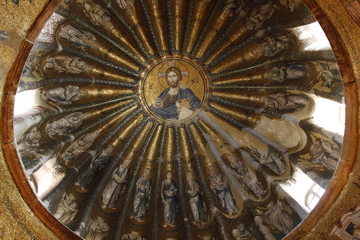
The ancestors of Christ from Adam onwards at Chora Church, Istanbul: used under Creative Commons licence © José Luiz Bernardes Ribeiro
Throughout this month we remain in the season of Epiphany, still with the theme of the light of Christ coming to the whole world. Last month, we saw Jesus shown to non-Jews (the ‘gentiles’) at the visit of the magi, then revealed to the whole world as the Son of God at his baptism in the Jordan. And February starts with ‘Candlemas’, when Mary and Joseph took Jesus to Jerusalem to offer the ritual sacrifice in the Temple, where they encountered Simeon, who prayed the prayer we know as the Nunc Dimittis, the prophecy of the redemption of the world by Jesus recorded in Luke 2:29–32.
What has all this to do with the picture?
Well, one of Jim Mein’s Epiphany sermons started: “People these days seem interested in their genealogy, so it seemed a good idea to look at Jesus’”, and went on to explore why the Gospel writer gives us his list.
Matthew 1:1–17 includes four women, three of them immigrants, and Jim commented that, when Matthew is “presenting a story of God and humanity coming together … we are given this genealogy that involves the outcast, the sinners, the people who in the Jewish laws of the time deserved to be stoned, beheaded, executed.”
He continued: “One thing we could learn is that God can, and does, use most unpromising material to work through” and ended firstly by suggesting that “it’s dangerous to dismiss anyone as being unimportant, insignificant … something they have done, or … will do, is really important to God’s plan”, and secondly asking: “What has God called you to do? … what might you be remembered for?”
“We all grow out of our heritage, some of it will have been helpful, some not, and future generations – not just our own bloodline but the influence we have been on many people – future generations will grow out of what we leave. It’s a scarey thought, very scarey, but that whole mess is what God works through. We can help, or hinder, but God will keep working.”
You can read the whole sermon at this link

